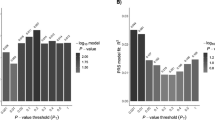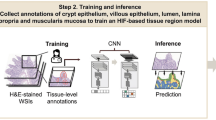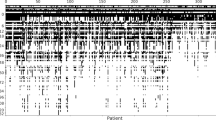Abstract
Celiac disease is an inflammatory enteropathy caused by intolerance to gluten. Previous linkage studies in the Dutch, Finnish and Hungarian populations have revealed a locus on chromosome 6q21-22 conferring susceptibility to celiac disease. This locus has previously been implicated in susceptibility to other autoimmune diseases such as Crohn's disease and type 1 diabetes. We performed fine mapping on 446 independent individuals with celiac disease and 641 controls of Dutch origin, testing 872 tagging SNPs in a 22 Mb region of chromosome 6. The 12 most promising SNPs were followed up in 2071 individuals from 284 Finnish and 357 Hungarian celiac disease families to identify risk variants in this region. Multiple markers in the region were significantly associated with celiac disease in the Dutch material. Two SNPs, rs9391227 and rs4946111, were significantly associated with celiac disease in the Finnish population. The association to rs9391227 represents the strongest association signal found in the Finnish (P=0.003, OR 0.66) as well as the combined Dutch, Finnish and Hungarian populations (P=3.6 × 10−5, OR 0.76). The rs9391227 is situated downstream of the HECT domain and ankyrin repeat containing, E3 ubiquitin protein ligase 1 (HACE1) gene and is contained within a region of strong linkage disequilibrium enclosing HACE1. Two additional, independent, susceptibility variants in the 6q21-22 region were also found in a meta-analysis of the three populations. The 6q21-22 region was confirmed as a celiac disease susceptibility locus and harbors multiple independent associations, some of which may implicate ubiquitin-pathways in celiac disease susceptibility.
Similar content being viewed by others
Log in or create a free account to read this content
Gain free access to this article, as well as selected content from this journal and more on nature.com
or
References
Marsh MN : Gluten, major histocompatibility complex, and the small intestine. A molecular and immunobiologic approach to the spectrum of gluten sensitivity (‘celiac sprue’). Gastroenterology 1992; 102: 330–354.
Lohi S, Mustalahti K, Kaukinen K et al: Increasing prevalence of coeliac disease over time. Aliment Pharmacol Ther 2007; 26: 1217–1225.
Ravikumara M, Tuthill DP, Jenkins HR : The changing clinical presentation of coeliac disease. Arch Dis Child 2006; 91: 969–971.
Greco L, Romino R, Coto I et al: The first large population based twin study of coeliac disease. Gut 2002; 50: 624–628.
Molberg O, Mcadam SN, Korner R et al: Tissue transglutaminase selectively modifies gliadin peptides that are recognized by gut-derived T cells in celiac disease. Nat Med 1998; 4: 713–717.
van Heel DA, Franke L, Hunt KA et al: A genome-wide association study for celiac disease identifies risk variants in the region harboring IL2 and IL21. Nat Genet 2007; 39: 827–829.
Dubois PC, Trynka G, Franke L et al: Multiple common variants for celiac disease influencing immune gene expression. Nat Genet 2010; 42: 295–302.
Van Belzen MJ, Meijer JW, Sandkuijl LA et al: A major non-HLA locus in celiac disease maps to chromosome 19. Gastroenterology 2003; 125: 1032–1041.
Hunt KA, Zhernakova A, Turner G et al: Newly identified genetic risk variants for celiac disease related to the immune response. Nat Genet 2008; 40: 395–402.
Trynka G, Zhernakova A, Romanos J et al: Coeliac disease associated risk variants in TNFAIP3 and REL implicate altered NF-kappaB signalling. Gut 2009; 58: 1078–1083.
Working group of European Society of Paediatric Gastroenterology and Nutrition. Anonymous revised criteria for diagnosis of coeliac disease. Report of working group of european society of paediatric gastroenterology and nutrition. Arch Dis Child 1990; 65: 909–911.
Monsuur AJ, de Bakker PI, Alizadeh BZ et al: Myosin IXB variant increases the risk of celiac disease and points toward a primary intestinal barrier defect. Nat Genet 2005; 37: 1341–1344.
Koskinen LL, Einarsdottir E, Dukes E et al: Association study of the IL18RAP locus in three European populations with coeliac disease. Hum Mol Genet 2009; 18: 1148–1155.
Koskinen LL, Korponay-Szabo IR, Viiri K et al: Myosin IXB gene region and gluten intolerance: linkage to coeliac disease and a putative dermatitis herpetiformis association. J Med Genet 2008; 45: 222–227.
van Belzen MJ, Vrolijk MM, Meijer JW et al: A genomewide screen in a four-generation Dutch family with celiac disease: evidence for linkage to chromosomes 6 and 9. Am J Gastroenterol 2004; 99: 466–471.
O′Connell JR, Weeks DE : PedCheck: a program for identification of genotype incompatibilities in linkage analysis. Am J Hum Genet 1998; 63: 259–266.
Barrett JC, Fry B, Maller J, Daly MJ : Haploview: analysis and visualization of LD and haplotype maps. Bioinformatics 2005; 21: 263–265.
Dudbridge F : Pedigree disequilibrium tests for multilocus haplotypes. Genet Epidemiol 2003; 25: 115–121.
Purcell S, Cherny SS, Sham PC : Genetic power calculator: design of linkage and association genetic mapping studies of complex traits. Bioinformatics 2003; 19: 149–150.
Paznekas WA, Karczeski B, Vermeer S et al: GJA1 mutations, variants, and connexin 43 dysfunction as it relates to the oculodentodigital dysplasia phenotype. Hum Mutat 2009; 30: 724–733.
van Steensel MA, Spruijt L, van der Burgt I et al: A 2-bp deletion in the GJA1 gene is associated with oculo-dento-digital dysplasia with palmoplantar keratoderma. Am J Med Genet A 2005; 132A: 171–174.
Diosdado B, Stepniak DT, Monsuur AJ et al: No genetic association of the human prolyl endopeptidase gene in the Dutch celiac disease population. Am J Physiol Gastrointest Liver Physiol 2005; 289: G495–G500.
Acknowledgements
All the study subjects are thanked for participating in the study. We thank the Dutch Celiac Disease Foundation for participating in this study, and H van Someren and F Mulder for clinical database. We thank Wieke HM Verbeek for help in sample collection and Jackie Senior for critical reading of the manuscript. We thank Hanne Ahola and Anne Heimonen for excellent technical assistance and Erzsébet Szathmári, Judit BKovács, Margit Lörincz and Anikó Nagy for their work with the Hungarian families. We thank Carolien de Kovel at UMC Utrecht for providing unpublished data on the population structure of the Dutch cohort. We acknowledge funding from the Coeliac Disease Consortium (an innovative cluster approved by the Netherlands Genomics Initiative and partly funded by the Dutch Government, grant BSIK03009 to CW), the Netherlands Organization for Scientific Research (VICI grant 918.66.620 to CW) and the Dutch Digestive Disease Foundation. This work has been funded by the EU Commission through a Marie Curie Excellence Grant (FP6 contract MEXT-CT-2005-025270 to PS), by the Academy of Finland, the Hungarian Scientific Research Fund (contract OTKA 61868), the University of Helsinki Funds, Biocentrum Helsinki, the Competitive Research Funding of the Tampere University Hospital, and the Foundation of Pediatric Research and the Sigrid Juselius Foundation.
Author information
Authors and Affiliations
Corresponding author
Ethics declarations
Competing interests
The authors declare no conflict of interest.
Additional information
Supplementary Information accompanies the paper on European Journal of Human Genetics website
Supplementary information
Rights and permissions
About this article
Cite this article
Einarsdottir, E., Bevova, M., Zhernakova, A. et al. Multiple independent variants in 6q21-22 associated with susceptibility to celiac disease in the Dutch, Finnish and Hungarian populations. Eur J Hum Genet 19, 682–686 (2011). https://doi.org/10.1038/ejhg.2011.2
Received:
Revised:
Accepted:
Published:
Issue date:
DOI: https://doi.org/10.1038/ejhg.2011.2
Keywords
This article is cited by
-
Genomic and immunohistochemical profiles of enteropathy-associated T-cell lymphoma in Japan
Modern Pathology (2015)



